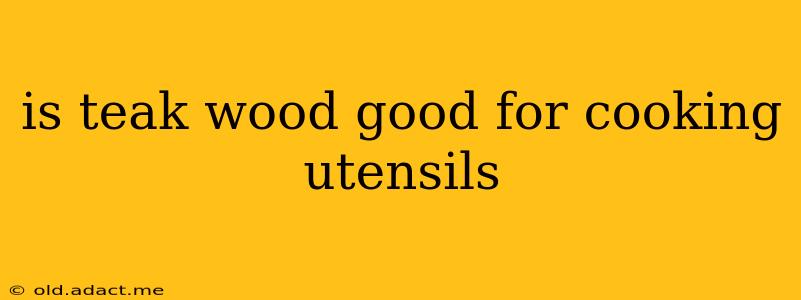Teak wood, renowned for its durability and water resistance, is a popular choice for outdoor furniture and boat building. But is it suitable for cooking utensils? The answer is nuanced, and understanding its properties is key to making an informed decision. This guide will explore the pros and cons of using teak wood in the kitchen, addressing common questions and concerns.
What are the advantages of using teak wood for cooking utensils?
While not as common as other wood types like bamboo or maple, teak does offer some advantages for specific kitchen applications:
- Durability: Teak is incredibly dense and resistant to rot, making it a long-lasting material. This means your utensils could withstand regular use and cleaning for years.
- Water Resistance: Its natural oils provide resistance to water absorption, minimizing the risk of warping or cracking from moisture. This makes it relatively easy to clean and maintain.
- Aesthetic Appeal: Teak's rich, warm color and beautiful grain add a touch of elegance to any kitchen. Many people find it visually appealing compared to more commonplace materials.
- Heat Resistance (to a degree): While not ideal for direct heat contact, teak can handle brief exposure to moderate temperatures better than some softer woods.
What are the disadvantages of using teak wood for cooking utensils?
Despite its positive qualities, several drawbacks need consideration:
- Porosity: Though water-resistant, teak wood is still porous. While this isn't a major issue with proper care, prolonged exposure to moisture or acidic ingredients could lead to staining or bacterial growth. Thorough drying after each use is crucial.
- Oil Treatment: Most teak utensils will require some form of oil treatment to maintain their water resistance and longevity. This involves regular oiling which can be time-consuming.
- Not Suitable for High Heat: Teak should never be exposed to direct flame or high heat. It will scorch, crack, and potentially release harmful compounds.
- Cost: Teak wood is often more expensive than other materials commonly used for cooking utensils, such as bamboo or silicone.
Is teak wood safe for cooking utensils?
Teak itself is generally considered safe for food contact, provided it is properly maintained and treated. However, the type of oil used to treat the wood is crucial. Avoid any oil that's not food-safe, and opt for mineral oil or food-grade cutting board oil. Always wash your teak utensils thoroughly after each use.
Can teak wood cooking utensils be used in the dishwasher?
No. Putting teak wood utensils in the dishwasher is strongly discouraged. The high heat and harsh detergents can damage the wood, causing it to crack, warp, or lose its natural oils. Hand washing with warm, soapy water is always recommended.
How do I care for teak wood cooking utensils?
Proper care is essential for extending the life of your teak utensils. This involves hand washing with warm soapy water, thoroughly drying them immediately afterward, and regularly applying a food-safe oil to maintain their water resistance and prevent cracking.
What type of oil should I use for teak wood cooking utensils?
Use food-grade mineral oil or a food-safe cutting board oil. Avoid using vegetable oils, as they can become rancid over time.
Is teak wood better than other wood types for cooking utensils?
The "best" wood for cooking utensils depends on individual needs and preferences. Teak offers durability and water resistance, but its cost and maintenance requirements might make other options like bamboo or maple more practical for many cooks.
Conclusion:
Teak wood can be used for certain cooking utensils, particularly those with minimal heat exposure like serving spoons or spatulas. However, its cost, maintenance, and limitations regarding heat make it a less common choice compared to other wood types. Consider your needs and budget carefully before opting for teak for your kitchen tools. Proper care is essential to ensure the longevity and safety of your teak cooking utensils.
